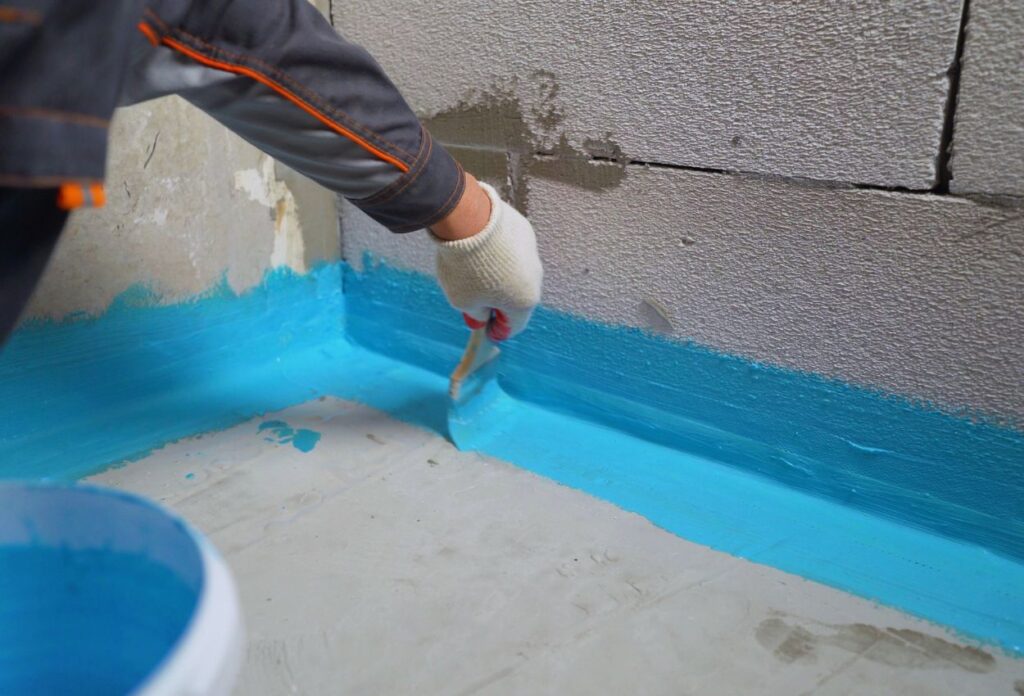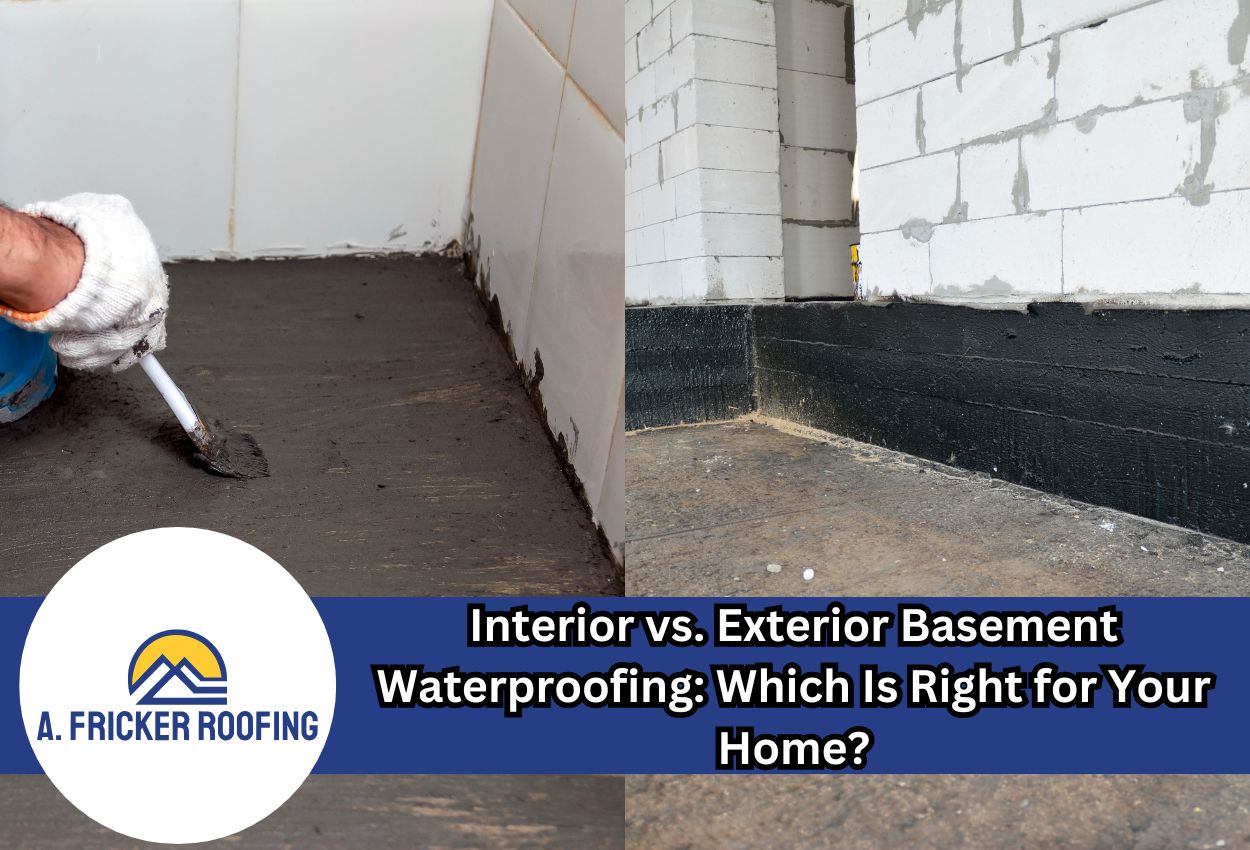Imagine this: you head down to your basement after a heavy rainstorm, only to find a damp floor and an unpleasant musty smell. It’s a scenario no homeowner wants to face, but it’s more common than you might think. Basement waterproofing is the key to avoiding situations like these, protecting your home’s foundation, and maintaining a healthy living environment.
But when it comes to waterproofing, you’re faced with an important decision: Should you go with interior or exterior waterproofing? Each method has benefits and considerations, and understanding them can make all the difference in finding the right solution for your home. As experts in waterproofing, we’re here to guide you through the process and help you make the best choice.
What Is Basement Waterproofing, and Why Is It Important?

Basement waterproofing is the process of preventing water from entering your basement, protecting your home from damage. Water infiltration can cause significant problems, including:
- Mold growth, which can impact air quality and health.
- Cracks in the foundation, compromising the structural integrity of your home.
- Decreased property value and increased repair costs.
Addressing basement water issues proactively is crucial to keeping your home safe and dry. Whether you’re dealing with persistent leaks or want to prevent future problems, waterproofing is an investment in your home’s longevity and comfort.
With decades of experience helping homeowners protect their homes, we’ve seen firsthand how the right solution can transform a basement into a dry, worry-free space.
What to Know About Interior Basement Waterproofing
Interior basement waterproofing is the type of waterproofing that is done on the inside of the foundation walls, i.e., inside your basement. Waterproof materials and techniques are used to prevent water from coming inside. In most cases, this technique also involves managing water that has already entered the basement.
Common methods include:
- Installing drainage systems along the interior perimeter to channel water to a sump pump.
- Applying sealants to walls and floors to block moisture.
- Adding vapor barriers to reduce dampness.
Pros Of Interior Waterproofing
Cost-Effective
Interior waterproofing is typically a more affordable option compared to exterior methods. This is because it doesn’t involve labor-intensive excavation around the foundation or the installation of external drainage systems. For homeowners on a budget or those dealing with moderate water issues, this approach offers an economical way to protect their basement.
Quick to Implement
Since interior waterproofing doesn’t require digging around the outside of the home, the process is faster and less disruptive. Techniques like applying waterproof coatings to walls, installing interior drainage channels, or setting up a sump pump system can often be completed in a few days or less.
Ideal for Certain Situations
Interior waterproofing shines in scenarios where exterior work isn’t practical or possible. For instance:
- Homes in urban areas with limited yard space or closely spaced neighbors.
- Properties where excavation might disrupt landscaping, patios, or driveways.
- Buildings with structural constraints or where exterior access is restricted.
Limitations Of Interior Basement
Doesn’t Address the Source
One of the primary drawbacks of interior waterproofing is that it doesn’t tackle the root cause of the problem: water infiltrating your home’s foundation. Instead, it focuses on managing water that has already entered the basement. Homeowners facing persistent water infiltration or significant exterior drainage issues may find that this method only offers a temporary fix.
Maintenance Required
Unlike exterior waterproofing, which can often be installed and left to function for years with minimal intervention, interior systems require ongoing attention. For example, sump pumps need regular care and maintenance.
What to Know About Exterior Basement Waterproofing
Next, let’s talk about the external methods. As the term suggests, exterior waterproofing includes all options that protect the outside foundation walls. This is a more comprehensive approach to waterproofing and is more popular when you are moving into a new property. The process can vary depending on the type of foundation.
This method involves:
- Excavating around the home to uncover the foundation.
- Installing waterproof membranes or coatings to create a protective barrier.
- Adding drainage systems, like French drains, to redirect water away from the foundation.
Pros of Exterior Waterproofing
Comprehensive Protection
Exterior waterproofing prevents water from reaching your foundation entirely, addressing the root cause of leaks. By creating a protective barrier and installing drainage systems outside your home, it minimizes long-term risks like foundation cracks, water seepage, and structural weakening. This proactive approach means your basement stays dry, even during heavy rain or flooding.
Durability
Properly installed exterior waterproofing systems are built to last. High-quality materials like waterproof membranes and professional-grade drainage systems can protect your home for decades with little maintenance. This durability provides homeowners with lasting peace of mind, knowing their foundation is safeguarded against water damage.
Cons of Exterior Waterproofing
Higher Initial Cost
Exterior waterproofing typically involves significant excavation around your home, as well as the installation of advanced materials and systems. These factors make it more expensive upfront compared to interior solutions. However, the long-term benefits often outweigh the costs, as it reduces the likelihood of ongoing repairs or damage.
Disruption
The excavation process can temporarily disrupt your property, including landscaping, patios, or driveways. While professionals work to minimize the impact, it’s important to be prepared for some level of disturbance during the installation process. That said, the end result—a dry, protected basement—makes this temporary inconvenience worthwhile.
To know more about the techniques used in both interior and exterior basement waterproofing, read our blog post: Basement Waterproofing 101: Pros, Cons & Costs
Interior vs. Exterior Basement Waterproofing: The Differences
| Basis | Interior Basement Waterproofing | Exterior Basement Waterproofing |
| Purpose | To manage and prevent water seepage inside the basement. | To prevent water from entering the basement from outside. |
| Application | Applied to the inside foundation walls. | Applied to the exterior of the basement walls or foundation. |
| Cost | Less expensive than external methods. | Some methods can be expensive. |
| Installation | Easier and faster installation. | Complex installation. |
| Durability | Less durable and may need maintenance over time. | These are long-term focused. |
| Disruption | Minimal disruption, as it’s done inside the basement. | Very disruptive. |
Also Read: Best Basement Waterproofing Products Of 2025
How to Decide: Interior or Exterior Waterproofing?
Choosing the right waterproofing method depends on several factors:
- Budget: Interior solutions are typically more affordable initially, while exterior methods offer long-term value.
- Water Issue Type: Persistent leaks or severe flooding might call for exterior waterproofing, while minor dampness can often be managed internally.
- Foundation Condition: Exterior waterproofing may be necessary if there are signs of structural damage.
- Urgency: Interior waterproofing can provide a quicker fix if immediate action is needed.
Still unsure? That’s where we come in. We offer free consultations to assess your specific situation and provide expert recommendations tailored to your home and budget.
Also Read: The Truth About DIY Basement Waterproofing: Is It Worth the Effort?
Conclusion
Deciding between interior and exterior basement waterproofing is an important step in protecting your home. Each option has different benefits, and the right choice depends on your home’s needs, budget, and water issues.
No matter which option you choose, A. Fricker Roofing and Waterproofing is here to help. From comprehensive assessments to expert installations, we provide solutions that keep your home safe, dry, and comfortable for years to come.
Don’t let water issues compromise your home’s foundation or peace of mind. Contact us today at (918) 402-7167 for a free consultation and take the first step toward a worry-free basement.

